-
Posts
2,351 -
Joined
-
Last visited
Content Type
Profiles
Forums
Store
Help Articles
Posts posted by Patrick S
-
-
Does anyone have any rules-of-thumb as far as how much xanthan gum to use for a given quantity of liquid? Since it is soluble in hot or cold liquids, and doesn't have to be boiled to thicken, I suppose you could just add it bit by bit until you got the viscosity you wanted, but it would be good to know what general rules there might be.
ETA: I checked a few sites, and for thickening sauces, somewhere in the neighborhood of 1t per cup seems to be recommended.
-
http://www.foodproductdesign.com/
Do a search for 'xanthan' and read the articles. It'll tell you all the do's and don'ts.
Thanks Scott. There is a lot of good information there.
-
An odd asside; there was a rumor that Osama bin Laden's family controlled the world's supply of the substance, which is produced in Sudan.
Actually, the rumor was in regard to Acacia gum, aka gum arabic, which is derived from Acacia trees and is in fact largely supplied to the rest of the world by Sudan. Xanthan gum, on the other hand, is produced from a Xanthamonas bacterium, and was actually discovered by the USDA. I think the largest producer in the world is the US based company CP Kelco.
-
Oh, no wait.... I see what you're saying......make the choux, dip in caramel, then store in the sealed container with dessicant, until you're ready to fill. I do believe that could totally work. The only drawback is that the choux would definitely lose it's "crispityness" and might be somewhat leathery.
Wouldn't be quite as good as the a la minute method, but might be marginally suitable......
I hate how choux gets soft after a while too, but doesn't it get soft because it starts out pretty dry and then absorbs water? If that's the case, maybe the dessicant would help with that too?
-
I wonder how long the caramel would last if you kept the pastries in a sealed container with a desiccant bag?
-
Hydrogenated ANYTHING is really bad for you. The health risks have prompted Denmark to ban all products containing it. The US government recently began requiring food products to be labeled for trans-fats. You would be amazed how many products use it. I've become a food label detective lately!
The new products containing fully hydrogenated oils, such the new Crisco mentioned above, do not contain trans-fats. The enemy is not hydrogenation per se (which merely thickens and prevents oxidation -- good things in many circumstances), the enemy is trans-fatty acids, which are created by the process of partial hydrogenation (well, they are also present in dairy products, like butter, where they come from microbial hydrogenation, but the quantities are trivial).
-
Yes I've done it. No you use it dry, as a powder. Eillee-een, Dream Whip is every bit as wholesome and natural as refined flour, refined cake flour, refined sugar and baking powder, buttermilk, vanilla extract, sour cream, etc. All of those so called scratch ingredients are either highly refined or totally processed and concocted. Don't you think??? And I like all of 'em, shortening too and lard. Let him who is without phyllo dough in the freezer cast the first cupcake.

Touche!
-
I would NOT use canola oil. Canola oil that is sold as a food product is highly processed. It is originally Rapeseed oil, and is naturally highly toxic.
Just to clarify, canola oil is not derived from a toxic oil, though the canola plant is derived from rapeseed, which does produce an oil with a lot of urecic acid (as does mustard seed). The canola plant itself does not produce the high levels of erucic acid or glucosinolates that make oils from other rapeseed cultivars toxic and unpleasant tasting.
-
The milk chocolate passion fruit truffles are really good.
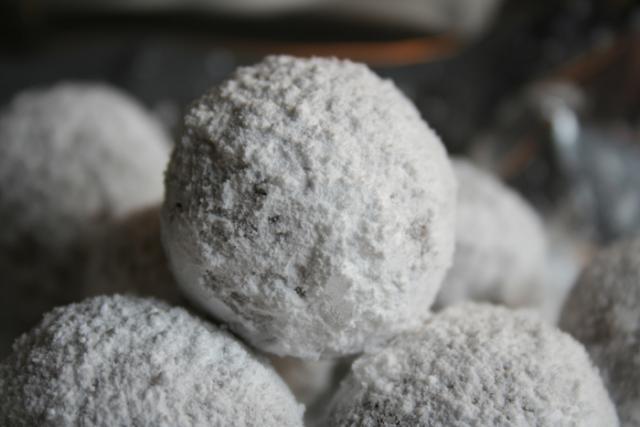
Honestly, I didnt' like the passion fruit ganache tartlets I tried a while back very much. The combination of bitter chocolate and acidic fruit didn't work for me. But these truffles, which are much sweeter, are great. The finely-diced apricots also work great here. I normally don't care much for apricots, but here they add a nice chew to the truffles.
Those look great!
i've made this recipe twice before and it didn't work for me very well - ganache was to loose to roll. first time used fresh pfruit. second time frozen puree. same problem to varying degrees. can't remember what brand of chocolate i used the first time (2 1/2 yrs ago) but i know the last time i used shokinag (milk ofcourse). don't know the vital %'s of the top of my head, but i wouldn't think it would be enough variance from valrhona to cause the ganache to be as slack as it was. my second batch eventually worked out with the addition of more choc, but the flavor obviously suffered a bit - xtra choc kinda muddied up the the bright notes of the pfruit.
well, any thoughts or tips with this recipe?
would like to get this recipe worked out a little better. i guess i could always use it in a molded chocolate - it is very yummy.
Like yours, mine turned out very soft, and I think they are best right out of the refrigerator. I used a lightly sweetened puree, and I reduced it a little so that it got a little syrupy and didn't have so much water. I did increase the chocolate, but only by a few grams -- not because I knew the truffles were going to be soft, but because I accidentically added too much to the bowl and didn't bother to take it out. I also used about 2T more butter than the recipe called for.
To shape the truffles, I cut the chilled ganache bar into tablespoonish chunks, which I rolled in sugar just briefly, stopping when it starts to get squishy, even if the truffle isn't really formed. After all the chunks have been coated once, I chilled them again, and then rolled them again, and then chilled again before serving.
-
Yea but then you dont have a coulis any more, you have a berry flavored syrup.
The whole point of the "coulis" is the fruit pulp. Am I wrong?
Yes, I think so.
I did a Google define:coulis search. It returned 10 results. Of those that seem relevant here, several of them specifically have the word sieved or strained in the definition. So yes, I would say that strained sweetened fruit puree is still a coulis, and would not cease to be a coulis by virtue of being strained (which doesn't remove all the pulp anyway, just the fraction that is too large to fit through the pore spaces). I also don't think it matters whether your puree, strained or not strained, is sweetened with simply syrup or with sugar. I certainly would consider a sauce made by cooking, pureeing, and straining raspberries, and sweetened with simple syrup, to be a coulis.
-
I am attempting this cake for the first time and am making the components over a few days. Last night, I made the caramel cremeux layer, it came out quite bitter. I followed the instructions as given. I think that there are 2 steps that may have given me the bitter flavour: either I over caramelized my sugar (it was just a touch over the perfect dark amber colour and didn't smell burnt before I added the cream) or the vanilla that I (silly move) added before putting the yolks in and returning the pot to the heat.
You slightly overcaramelized the sugar. Cooking the vanilla wouldn't do it. All the sweetness in the cremeux comes from the caramelized sugar (or which there is not much to begin with), and sugar looses its sweetness rapidly as it caramelizes. I already decided that when I make the cremeux next time, I will be replacing some of the cream with syrup to sweeten it up a little.
-
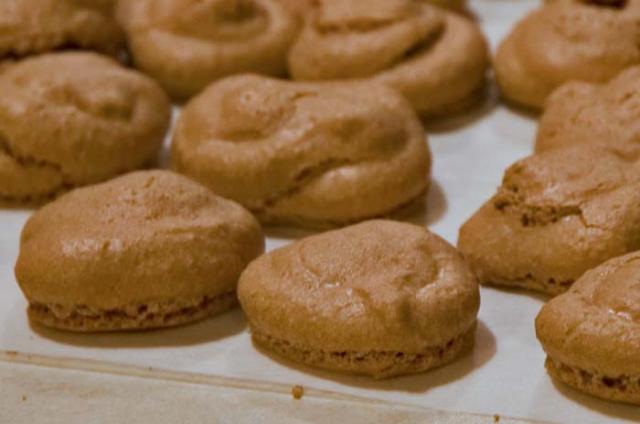
Good job. My first macaroons were cracked all over and didn't look as good as yours.
Your batter was slightly too thick. You can test your batter before you fill your pastry bag by dropping a little on a plate. It should slowly (over maybe 30 seconds to a minute) flatten into a smooth surface. If it doesn't, keep folding. If it still is too stiff, you can actually mist a little water onto your batter and fold it in to thin it out. Not too much though -- the shape of the macaroons are very sensitive to the moisture content of the batter: slightly too much, and you have very thin cookies; slightly too little, and you have macaroons with a craggy, irregular surface.
BTW, why did you pipe in circles? I would definitely try piping them with the tip held in place. Try piping with the tip held in place, raising the tip slightly as you pipe, so that you form a little mound. If the batter if just right, it will sink juuuust enough so that the cookies are slightly domed but still smooth.
-
thats not a coulis though. Isn't a coulis suppose to be simple processed fruit pulp with added simple syrup?
Coulis is one of several interchangeable pastry terms. To me it implies nothing but a clear sauce.
I think powdered agar is the best way to go. Cornstarch tastes...like cornstarch, and gums are slimy even in small doses.
Wait what? coulis clear? never heard of it, not once. Is it possible the coulis you tried was the creative use of the term ie. "coulis"? huh, perhaps I'm about to learn something new

Same here. I've always thought of it as a fruit sauce, but it is also commonly used to mean "sauce" in general. I didn't know anyone used it to mean a clear sauce specifically.
-
Just wanted to see what the full-sized image looks like! You linked to the thumbnail. Dacquoise with caramel ganache sounds delicious to me.
-
i see they are making vegetable shortening that has no trans fats. does anyone know if this is any good?
Cook's Illustrated compared fried chicken made with both versions of Crisco, and said that they couldn't tell the difference. They did however claim to detect subtle differences in pie crust and biscuits.
-
The milk chocolate passion fruit truffles are really good.

Honestly, I didnt' like the passion fruit ganache tartlets I tried a while back very much. The combination of bitter chocolate and acidic fruit didn't work for me. But these truffles, which are much sweeter, are great. The finely-diced apricots also work great here. I normally don't care much for apricots, but here they add a nice chew to the truffles.
-
The chocolate with the fat removed is cocoa powder.
A lot of the cocoa butter is pressed out, but not all of it! Cocoas usually still have cocoa butter content of 10-20%.
-
- Bittersweet has no sugar added and is nasty to eat.
No sugar=unsweetened, and I agree -- its nasty by itself.
-Semi-sweet has some suger added and isn't pleasant to eat either. Similar uses to bittersweet I'm guessing.I'd venture to say that %90+ of chocolate lovers would pick a bitter- or semisweet chocolate as their favorite eating chocolate. For instance, my favorite is a 64% (Valrhona Manjari). Basically, anything that has some sugar but is not milk or white chocolate would be considered bitter- or semisweet.
-Cocoa powder: I know dutch processed is supposed to be smoother or less alkali or something. I don't know if cocoa powder is bittersweet or semisweet or something else and why you'd choose one over the other.Cocoa powder is almost always sold unsweetened. Dutch is different from natural cocoa by have a different flavor and a higher pH. In some recipes the differences in pH matter, in others it doesn't. Usually the only reason it would matter is because of its interaction with the leavening agents in a recipe. In something like hot cocoa, the only factor should be taste. Having said that, I have made lots of recipes with dutched where the recipe called for non-dutched, with no problems. You should experiment and see which you like better, because its all about personal preference. But for me, I much prefer dutched.
-
BTW, if you have a digicam, snap a pic!
-
Nothing to worry about. Your lobster salad is merely chock full of luminescent bacteria. . . It would be good to know whether these bacteria continue to luminesce after death, in which case the glow does not necessarily indicate a lot of living bacteria, or whether luminescence does indicate live bacteria, in which case I would hesitate to eat any more of this stuff. . .
-
Patrick, you just slay me! Did you have to pick up that croquette with fingers, or did the pudding manage to support it?
Thanks, Abra! The pudding was thick enough to support the croquettes. I was taking photos for at least 30 minutes, and they didn't sink into the pudding to any significant degree.
-
Coconut vanilla rice pudding with chocolate croquettes. I was going to make the croquettes with tapioca soup, from the recipe in Chocolate Desserts by Pierre Herme, but I couldn't find any large pearl tapioca locally, and didn't want to order any.
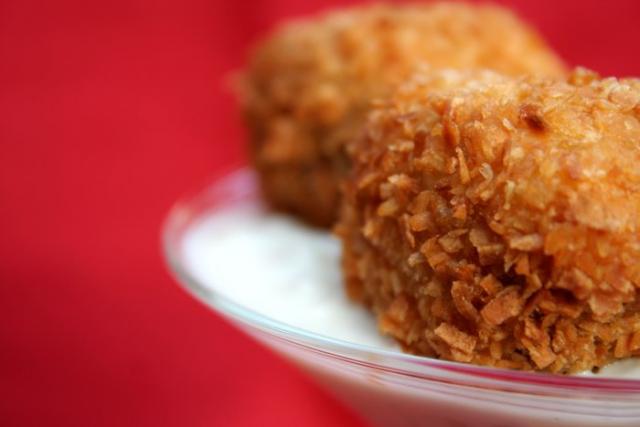
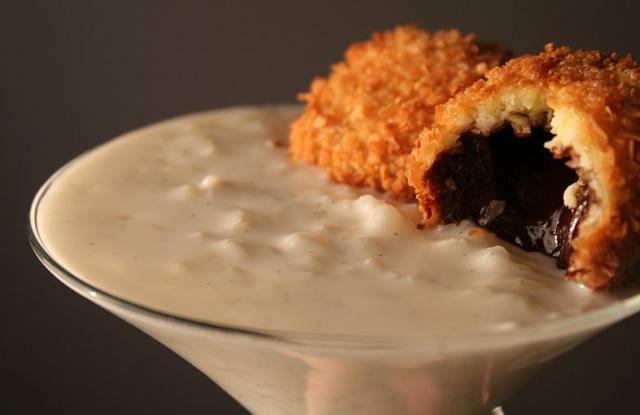
-
Theoretically you can patent a recipe, but it costs a lot of money, and a patent will only be granted if the technique or product is considered truly novel and nonobvious. When this issue first came up, I briefly searched patents at the US Trademark and Patent office, and couldn't find a single patent on a recipe like the kind you might find in a cookbook. Most of the patents I found were for things like methods for producing pork patties or instant pudding.
Most law firms would charge $5-10,000 to even file a patent application with the USPTO, and of course there is no gaurantee the patent will be granted. And then if you ever wanted to sue someone for infringing on your patent, that would cost more money, and there's no gaurantee of success. It appears to me that for the average professional baker/pastry person, the only way to keep you recipes is simply not to share them, but even then there is no way to prevent someone else from "reverse engineering" your bright ideas.
Do you have RLB's Pie and Pastry Bible, Patrick? She has a recipe for Lemon Pucker Pie that she either patented or trademarked, and I can't remember which (and am not at home to check it out).....
The USPTO database doesn't show any patents granted for any lemon pie recipes from 1976 to 2006, so I doubt she has a patent. She may well have a trademark, but trademarks only protect names/signs/logos, and not methods or products, trademark would only protect the use of the name "Lemon Pucker Pie"; you could sell pies made from the recipe, you just couldn't call it by that name.
-
A few comments...
Re the legalities of recipes: if you should decide to take them with you (leaving the employer empty-handed) when you leave, consult an attorney first. There are often nuances to situations like yours that make them, as far as legal aspects go, not what they appear to be to a layperson. (Trust me.) Sometimes it's because laws vary from state to state, and sometimes it's because of particular events that have transpired. A competent lawyer will question you to find out the scope of your situation and advise you accordingly. Don't go for the cheapest attorney you can find. You get what you pay for.
You do want to avoid a lawsuit. They are expensive, exhausting, and horrible. Getting a couple hundred bucks (or less) worth of legal advice before taking action may save you lots and lots of grief later. The attorney may also be able to give you helpful advice for how to stay out of this situation in the future.
Ethics-wise, I'd leave them. Your helpers aren't competent enough to really compete with you, and it wouldn't surprise me if they ditch them after awhile in favor of something simpler, and of lower quality, of course. Few people ever regret taking the high road. And you never know when a good recommendation from this employer will put you in a great job down the road. Think of them as a legacy; a young pastry chef may run across them one day, and you will have helped someone else get a good start. But my money's really with the idea that the people who have them, won't have the ability to appreciate them.
I think jdm some very good points. I want to add: I think recipes can be patented but then they become public knowledge when you submit them to the patent office.
Theoretically you can patent a recipe, but it costs a lot of money, and a patent will only be granted if the technique or product is considered truly novel and nonobvious. When this issue first came up, I briefly searched patents at the US Trademark and Patent office, and couldn't find a single patent on a recipe like the kind you might find in a cookbook. Most of the patents I found were for things like methods for producing pork patties or instant pudding.
Most law firms would charge $5-10,000 to even file a patent application with the USPTO, and of course there is no gaurantee the patent will be granted. And then if you ever wanted to sue someone for infringing on your patent, that would cost more money, and there's no gaurantee of success. It appears to me that for the average professional baker/pastry person, the only way to keep you recipes is simply not to share them, but even then there is no way to prevent someone else from "reverse engineering" your bright ideas.



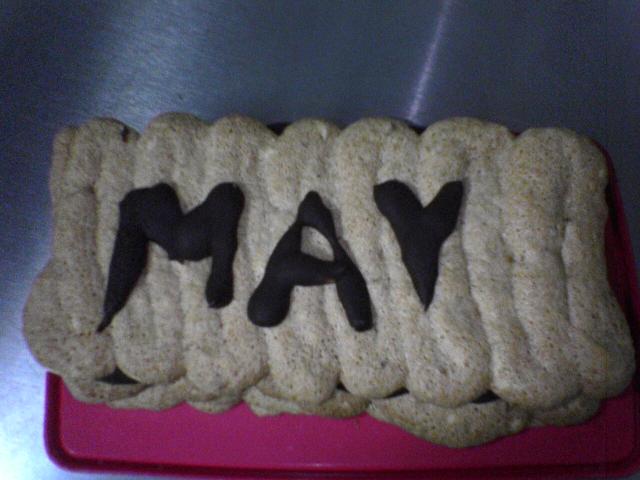
Xanthan
in Pastry & Baking
Posted
That's what I'm reading in the Food Product Design articles -- that the best effects are usually achieved with mixtures. I'm very much interested in hearing anything you want to say about how you have used these gums, singly or in combinations, and the successes and failures you've had. I'm curious in particular whether you've experimented with using these in ice creams.